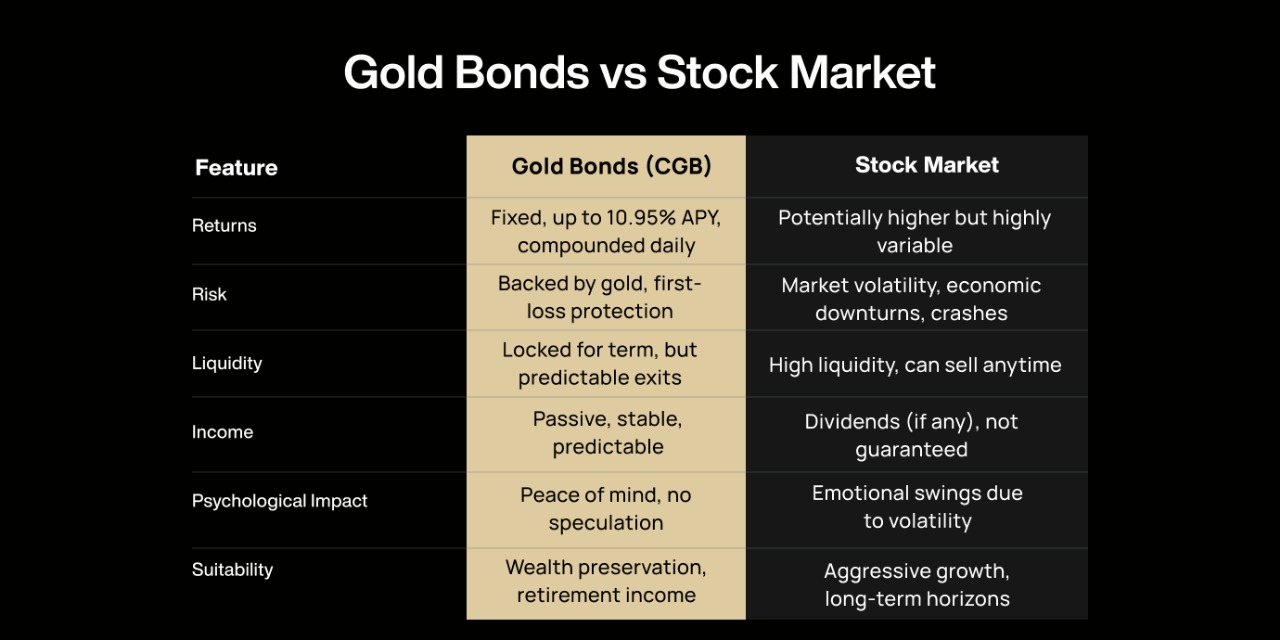For decades, investors have debated one of the biggest questions in wealth management: Is it smarter to chase the potential of the stock market or anchor your portfolio with the stability of gold?
The stock market has historically delivered impressive long-term gains, but it comes with volatility, unpredictable crashes, and emotional rollercoasters. On the other hand, gold has stood the test of time as a safe-haven asset, providing stability in uncertain times.
But today’s investors—especially accredited investors—are no longer limited to choosing between physical gold or equities. Gold bonds, such as Compound Gold Bonds™ (CGB), combine the timeless strength of gold with the reliability of fixed, compounding returns.
So, is investing in gold bonds a missed opportunity compared to the stock market, or the safe-haven your portfolio needs? Let’s dive in.
Understanding the Stock Market Opportunity
The stock market has long been regarded as one of the most powerful engines of wealth creation. For generations, investors have turned to equities as a way to build financial independence, participate in corporate growth, and benefit from the compounding power of reinvested returns.
How Equities Generate Wealth
At its core, stock market investing creates wealth in three main ways. First, through capital appreciation, where share prices rise as companies expand revenues, profits, and market dominance. Second, through dividends, as many established firms distribute a portion of their earnings to shareholders, creating a reliable stream of passive income. Finally, there is compounding growth—a powerful effect that occurs when investors reinvest dividends and allow gains to accumulate over time, leading to exponential growth in portfolio value.
The Upside of Stocks
The allure of stocks lies in their potential for strong long-term returns. Historically, broad indexes like the S&P 500 have averaged 7–10% annualized growth over decades, making equities one of the most rewarding asset classes for patient investors. Stock ownership also allows individuals to benefit directly from innovation, technological breakthroughs, and global expansion, as growing companies increase their market value. On top of that, stocks are highly liquid, enabling investors to buy and sell with relative ease, giving them unmatched flexibility compared to many alternative investments.
The Downside of Stocks
However, the stock market is not without significant risks. Volatility is one of its defining features—share prices can swing dramatically in response to economic data, political changes, or shifts in investor sentiment. There is also the constant risk of loss, as bear markets and financial crises can erase years of gains almost overnight. Beyond market forces, investors face behavioral risks: fear and panic often drive people to sell at the worst possible times, locking in losses rather than riding out downturns. Even fundamentally sound companies are not immune to short-term uncertainty, as broader market cycles can temporarily depress valuations regardless of performance.
In summary, while stocks offer the potential for high growth and wealth accumulation, they also carry inherent risks and unpredictability. Success in the stock market often requires a long-term mindset, emotional discipline, and tolerance for volatility—factors that not every investor is comfortable managing.
The Safe-Haven Role of Gold
Gold has earned its reputation as one of the world’s oldest and most trusted assets. For centuries, it has stood firm through wars, recessions, and currency collapses, serving as a safe-haven when other markets falter. Unlike many financial instruments that rise and fall with economic cycles, gold’s enduring value makes it a cornerstone in diversified portfolios.
Why Gold Attracts Investors
One of gold’s greatest appeals is its role as a crisis hedge. When economies falter, stock markets plunge, or geopolitical tensions rise, gold often appreciates in value as investors seek stability. It also acts as a natural inflation protector—while paper currencies lose purchasing power as the cost of living increases, gold historically retains or grows its value, safeguarding wealth against erosion. Beyond these benefits, gold enjoys universal acceptance. It is recognized and valued in every major economy, making it a global standard of trust and reliability across borders.
Limitations of Traditional Gold Investments
While gold is a powerful store of value, traditional ways of investing in it come with limitations. Physical gold, whether in the form of coins or bullion, demands secure storage and insurance, adding costs while generating no passive income. Gold ETFs offer easier access, but they simply track the price of gold and do not provide guaranteed returns, leaving investors dependent solely on market performance. Gold mining stocks add another layer of complexity, as their success is tied not just to gold prices but also to company management, operational efficiency, and broader market conditions—making them potentially more volatile than gold itself.
In short, gold remains a proven safe-haven asset, but traditional investment methods don’t always maximize returns. While it provides unmatched stability, investors often face trade-offs in the form of storage costs, market dependence, or volatility in related equities. This gap has led to the rise of more modern solutions like gold bonds, which aim to pair the reliability of gold with the wealth-building power of steady, compounding returns.
What Are Gold Bonds?
Gold bonds bridge the gap between stability and returns.
Definition
A gold bond is a financial instrument backed by physical gold assets but structured to provide fixed returns, often compounding daily.
Benefits of Gold Bonds
Gold bonds take the timeless security of gold and transform it into a modern wealth-building tool. Unlike traditional gold investments that rely solely on price fluctuations, gold bonds provide a combination of stability and consistent growth that appeals to investors who value both safety and returns.
Guaranteed Returns
One of the standout advantages of gold bonds is the promise of fixed returns. While physical gold and ETFs depend entirely on market prices, gold bonds lock in a predictable annual percentage yield (APY). This means investors don’t have to worry about whether the price of gold is rising or falling—they can count on stable income regardless of market volatility.
Gold-Backed Stability
Every gold bond is anchored to the value of a tangible, time-tested asset: gold itself. This backing gives investors peace of mind, knowing their investment is tied to one of the world’s most trusted stores of value. Even when other financial markets experience turbulence, the gold underpinning helps preserve capital.
No Storage Hassles
Owning physical gold comes with logistical challenges—secure storage, insurance, and ongoing maintenance costs. Gold bonds eliminate these headaches. As paper or digital instruments, they allow investors to gain exposure to gold without the risks and expenses of handling bars or coins.
Compounding Growth
Gold bonds don’t just preserve wealth; they actively grow it. With daily compounding, interest earned on the bonds is reinvested automatically, allowing returns to accelerate over time. This compounding effect means investors’ money works harder, turning stability into a powerful wealth-building mechanism.
Example: Compound Gold Bonds™ (CGB)
Among gold bond options, Compound Gold Bonds™ (CGB) stand out as a premium choice tailored for accredited investors.
- High Yields – Investors can earn up to 10.95% APY, significantly higher than most traditional fixed-income products.
- First-Loss Protection – A built-in safety layer ensures that investors’ capital is shielded from initial market shocks, adding an extra measure of security.
- Zero Fees – Unlike many investment vehicles that erode returns through management or transaction costs, CGB charges no fees or hidden expenses.
- Daily Compounding – Interest is compounded daily, maximizing the potential for passive income growth over time.
- Exclusive Access – CGB is available only to accredited investors, making it a premium opportunity designed for those who meet higher financial standards.
With these features, Compound Gold Bonds™ transform gold from a static safe-haven into an income-generating, growth-focused investment—bridging the gap between security and opportunity.
CGB transforms gold from a static asset into a dynaGold Bonds vs Stock Marketmic income-generating tool.
Gold Bonds vs Stock Market: Head-to-Head Comparison:
Here’s a clear breakdown:

Safe-Haven or Missed Opportunity?
The truth is—it depends on your goals.
- When Gold Bonds Make Sense
- Retirement-focused investors seeking guaranteed income.
- Those looking for stability and protection from market crashes.
- Accredited investors seeking high-yield, exclusive opportunities.
- Retirement-focused investors seeking guaranteed income.
- When Stocks Are Attractive
- Younger investors with decades before retirement.
- Those comfortable with volatility and aiming for high growth.
- Investors seeking liquidity and flexibility.
- Younger investors with decades before retirement.
- Balanced Approach
- A diversified portfolio may include both—stocks for growth, gold bonds for stability.
- The right allocation depends on risk tolerance, time horizon, and income needs.
- A diversified portfolio may include both—stocks for growth, gold bonds for stability.
Why Accredited Investors Choose Gold Bonds
Accredited investors have access to opportunities unavailable to the general public. Compound Gold Bonds™ stand out because:
- Premium Yields – Up to 10.95% APY, far above typical bonds or CDs.
- Daily Compounding – Accelerates wealth creation compared to annual compounding.
- First-Loss Protection – Built-in safety net reduces downside risk.
- Zero Fees – No hidden management or transaction charges.
- Gold-Backed Assurance – Stability from an asset that has survived for centuries.
For investors who prioritize capital preservation with meaningful returns, gold bonds are the modern evolution of safe-haven investing.

Conclusion
So, are gold bonds a safe-haven or a missed opportunity compared to the stock market?
The answer lies in your financial strategy. Stocks provide growth and liquidity but demand risk tolerance and patience. Gold bonds, on the other hand, deliver stability, predictability, and peace of mind.
For accredited investors seeking both security and strong returns, Compound Gold Bonds™ are not just a safe-haven—they’re a smarter way to preserve and grow wealth.
FAQs
1. Are gold bonds safer than the stock market?
Yes. Gold bonds are backed by gold assets and offer fixed, compounding returns, while the stock market is volatile and unpredictable.
2. Can gold bonds deliver better returns than equities over time?
While equities may outperform in bull markets, gold bonds provide consistent returns (up to 10.95% APY) regardless of market cycles.
3. What role do gold bonds play in retirement planning?
They provide steady, guaranteed income—ideal for retirees who value stability over speculation.
4. Are there risks associated with gold bonds?
Every investment has risk, but with first-loss protection and gold backing, CGB minimizes downside exposure.
5. Why are Compound Gold Bonds™ limited to accredited investors?
They are structured as exclusive, high-yield financial products designed for sophisticated investors who meet SEC accreditation standards.

.png)